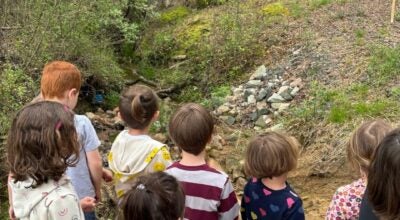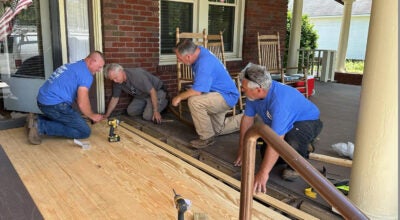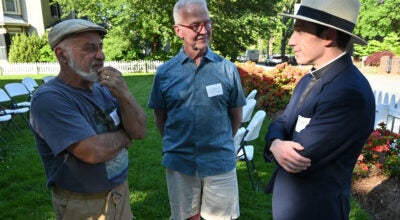From textiles to DNA: First Pillowtex employee to land a job at N.C. Research Campus now a lab technician
Published 12:00 am Thursday, April 23, 2009
By Emily Ford
eford@salisburypost.com
KANNAPOLIS ó Randy Crowell was just 6 years old when Spencer physician Dr. Charles Eddinger let him peer into a microscope during a check-up.
Staring at the flying saucer-shaped cells suspended in a drop of blood, Crowell felt as though he had discovered another world. The little boy decided he would become a scientist.
It took 44 years and layoffs at both Pillowtex and Duracell, but Crowell finally achieved his childhood aspiration. He works as a lab technician in the Core Laboratory at the N.C. Research Campus, sequencing DNA and pursuing his personal mission to help people through science.
“Dreams can come true,” Crowell said.
The Research Campus, a $1.5 billion biotechnology complex, rises from the ruins of an old textile mill in downtown Kannapolis.
Crowell knew the mill well. He worked for 20 years for the various textile manufacturers that owned the mill before he and more than 4,000 other people lost their jobs in July 2003, the biggest layoff in state history.
Crowell, who later earned an associate’s degree in biotechnology from a community college in Texas, has the distinction of becoming the first former Pillowtex employee to work in a lab at the Research Campus.
“Randy really epitomizes what the NCRC hopes to do for the town, ensuring that the campus represents a new beginning for the town,” said Dr. Simon Gregory, interim director of the genomics lab. He hired Crowell.
When Gregory, an investigator with the Duke University Center for Human Genetics, comes to the genomics lab in Kannapolis, Crowell thanks him for the job.
“I tell him, ‘Don’t thank me yet,’ ” Gregory said. “I want him to work really hard. I expect big things from him, but I have no doubt that he can deliver.”
– – –
As a boy, Crowell went to visit Dr. Eddinger whenever he could.
The doctor always sent him home with a handful of old test tubes or microscope slides. After much pleading, his parents, Maybelle and Ernest Crowell Sr., bought him a microscope and chemistry set. His grandfather gave him some old radio equipment.
Soon, Crowell had a fairly well-equipped lab in his bedroom on East Bank Street in Salisbury.
But the family had to evacuate several times due to smoke and fumes from Crowell’s experiments. Finally, his dad threw the entire lab in the trash.
His mother intervened, and Crowell retrieved his equipment. They compromised and he set up a lab in a small outbuilding behind their house.
He mixed chemicals. He grew molds. He studied bugs and plants. He repaired record players and radios.
“At the time, the word ‘science’ best described the way I had combined the fields of biology, chemistry and electronics,” Crowell said. “A couple of decades later, someone coined the work ‘biotechnology’ to describe it.”
– – –
Crowell began taking classes at Rowan-Cabarrus Community College as a teenager, everything from electronics to photography, and earned a high school equivalency diploma there.
He landed a job in 1974 as an electrician at the textile mill, troubleshooting problems at plants in Salisbury, Rockwell, Concord and Kannapolis.
Crowell had to think on his feet and invented several gadgets, including a drop-wire tester that saved Cannon Mills $35,000 in one year.
That type of problem solving serves him well in the Core Lab.
“Those 20 years in the mill benefit me every day,” he said.
After the mill closed, Crowell worked at a retirement center in Salisbury and pulled the graveyard shift at the Duracell plant in Lexington. He sometimes worked 80 hours a week.
But two and a half years later, he was laid off again when Duracell closed.
“As bad as the mill closing was, this was 10 times worse,” he said. “I was so full of fear and anxiety. It was a horrible time.”
He couldn’t find another job. Then his daughter called.
She had a 6-month-old son with severe birth defects and asked Crowell to move to San Antonio to help.
He was 48 years old and had never lived more than 25 miles from where he was born.
Crowell prayed. And then he moved.
It was one of the best decisions he’s ever made.
– – –
After searching for work in Texas for several months, Crowell decided to chase his childhood dream and enrolled at a local community college.
He studied DNA, the genetic code for the development of all cellular life.
As part of his program, he completed a 300-hour internship at a cancer research lab at the University of Texas at San Antonio.
Crowell’s mother died of cancer when he was 13. His father’s death followed 10 years later. He lost a brother and an uncle to the disease.
“I looked at cancer cells under the microscope and it just enraged me,” he said. “We have got to find something to stop it.”
Crowell said the Research Campus offers the best hope for finding new treatments, prevention or even a cure for cancer.
“They will make a real impact on human health here,” he said.
One of Crowell’s professors, Dr. John Bruno, invited him to work in his lab at the community college in Texas. After graduation, Crowell worked for Bruno’s biotech company, OpTech.
He helped develop a way to disable anthrax in the spore stage, a test to detect bacteria in food and a bone density monitor for astronauts on the International Space Station.
When his grandson’s health improved and his daughter’s family left San Antonio, Crowell moved to China Grove in October 2008, the same month the Research Campus officially opened.
He immediately applied for a job. He almost didn’t get it.
When Gregory offered Crowell an interview, he didn’t get the message. He had no phone line and no cell phone service at his new home.
Crowell happened to check his e-mail at the public library. He saw the offer and called, but all the interview slots had been filled.
Devastated, he asked if he could sit in the lobby in case someone didn’t show up.
The receptionist called him the next day and said a candidate had canceled. Crowell got the interview and the job.
“We were very impressed with how focused he was, how he had re-tooled and re-trained himself,” Gregory said.
Crowell’s time at the mill also made him stand out.
“He comes up with different ways to do things,” Gregory said. “He can think tangentially, and he can definitely apply those skills in multiple ways.”
Crowell is an inspiration, said Phyllis Beaver, marketing director for campus developer Castle & Cooke North Carolina.
“Do not give up,” said Beaver, who also worked for the mill. “He is exactly where God intended him to be. He just got there a little late.”
– – –
When asked for the best part of his job, Crowell answers quickly.
“The possibility of making a real difference in human health and alleviating suffering and disease,” he says.
Campus founder David Murdock probably couldn’t say it better himself.
The billionaire owner of Dole Food Co., Murdock also lost a loved one to cancer ó his wife, Gabriele ó and he used his anger at the disease as motivation.
After selling the textile mill in the 1980s, Murdock bought back the abandoned plant in 2004 to create the Research Campus.
Crowell met Murdock years ago and hopes to see him again, perhaps this week while he’s announcing an effort to cure multiple sclerosis.
“I will thank him,” said Crowell, who also teaches at a Bible college at Cornerstone Church. “He has enabled me to live out my dream.”
Crowell said he knows that some still blame Murdock for the downfall of textile manufacturing in Kannapolis.
“What he’s doing now should redeem that, but I don’t know if it’s going to,” Crowell said. “He could have done this anyplace, and he chose Kannapolis.”
Crowell and his colleagues at the Core Lab have nearly completed the first map of the blueberry genome, which could lead to new health discoveries.
Crowell, now 52, said he has no plans to retire.
“I don’t ever intend to retire,” he said. “It’s too important to stop.”




